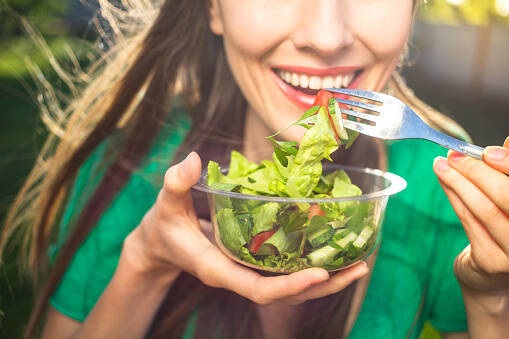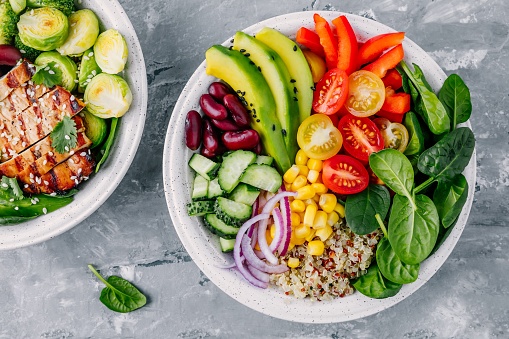- vaha.sk - energy value of food and calculation of energy value of food and own BMI
- cmaj.ca - Diet in the management of weight loss, Irene Strychar
- link.springer.com - Diet and Exercise for Weight Loss, Jeff S. Volek, Jaci L. VanHeest & Cassandra E. Forsythe
- nejm.org - Weight Loss with a Low-Carbohydrate, Mediterranean, or Low-Fat Diet, Iris Shai, R.D., Ph.D., Dan Schwarzfuchs, M.D., Yaakov Henkin, M.D., Danit R. Shahar, R.D., Ph.D., Shula Witkow, R.D., M.P.H., Ilana Greenberg, R.D., M.P.H., Rachel Golan, R.D., M.P.H., Drora Fraser, Ph.D., Arkady Bolotin, Ph.D., Hilel Vardi, M.Sc., Osnat Tangi-Rozental, B.A., Rachel Zuk-Ramot, R.N., et al., for the Dietary Intervention Randomized Controlled Trial (DIRECT) Group
- BÉDER, Igor et al. Physiologie člověka. UK Bratislava, 2009. ISBN 978-80-223-2569-1
Weight loss and diet: how to eat right, healthy and diet?

Weight loss is closely linked to diet. Overeating is not healthy. But losing weight by starving yourself is also a dangerous counterpart. So how do we eat right to maintain our dream figure and stay fit?
Article content
Weight loss and lifestyle change
It is the need to follow rules or guidelines that can make us feel resentful. However, a good lifestyle is not a set of norms that is meant to tell someone how to live. It is the lifestyle change itself.
If someone wants to lose weight, for example, they have to change it, because the current one has brought them something they no longer want or can identify with.
In our article on weight loss and fat burning, we wrote about physical activity as one of the components of a healthy lifestyle. However, exercise alone is not enough to effectively get rid of excess fat tissue. An equally important component of a proper lifestyle is dietary modification.
And just as it is important to expend increased amounts of energy when losing weight, it is important to reduce the intake of energy. One without the other in this case will not bring the desired result.
Once someone has embarked on this journey, it is in their own interest to stay on it. In the beginning, it will seem to most people like giving up a certain comfort. But over time, they will come to realise that it is just getting rid of unnecessary habits and bad habits.
Fundamentally, dietary modification does not mean starvation. That in itself is just as dangerous as overeating. It's just a matter of what to eat, when to eat, and in what quantities.
The diet must be varied and must contain all the ingredients necessary for the proper functioning of the body. Of course, also fats and sugars.
Each food component has a certain physiological importance for the organism.
Regulation of food intake
Food intake is controlled from the hunger centre and the satiety centre, which are located in the brain. These centres are connected and regulate a person's behaviour in terms of hunger or satiety.
If a person is full, the hunger centre is suppressed. If a person is hungry, the satiety centre is suppressed.
These centres receive stimuli from more distant parts of the body:
- hunger pangs - considered the most important hunger information, they occur several hours after a meal
- a drop in blood glucose levels
- increased blood temperature - suppresses hunger, while cold increases appetite
- hormones
A person's eating behaviour is strongly influenced by the desire and enjoyment of food. It is conditioned by social habits and food timings or stress factors.
Humans have lost the natural ability to consume only the necessary amount of food. Unlike wild animals, this may also affect their health.
A good lifestyle with the necessary and ideal food intake is a prerequisite for longevity and a high quality of life.
Regulating fluid intake
An increase in blood density or a decrease in blood volume in the bloodstream increases the feeling of thirst.
Thirst is an acute and subjective sensation of a lack of fluid in the body.
Hyperosmolarity of blood plasma, i.e. an increase in blood density of only 2 to 3 %, increases the sensation of thirst very strongly. A decrease in blood volume of 10 to 15 % results in the same sensation.
Other factors that induce thirst are dryness of the oral mucosa and reduced saliva production.
Proper nutrition
Nutrition means the supply of substances to the body that ensure the proper functioning of its vital processes.
Once food is taken into the body, energy and chemical transformations begin to take place. These include the processing of food, its digestion, absorption and distribution of nutrients to the cells. All these processes involve metabolism.
Proteins, sugars and fats provide us with energy intake. They are processed and as a source of energy are needed for energy expenditure, which in the body includes:
- anabolism - the construction of various tissues and structures
- mechanical work - contraction of muscles, movement of cells and organs
- membrane transport - anions, cations, minerals, organic substances
- information transmission - the generation and propagation of action potentials in nerve cells and their synaptic transmission
- immunity - defence reactions and immunity
- thermoregulation - heat generation and dissemination
- catabolism - splitting of substances, oxidation-reduction processes
Nutrients are substances that are needed for the proper functioning of the body. It is important that they enter the body in full breadth and in sufficient quantities. Some can be made by the body itself, but most are obtained through food.
The nutrients that the body cannot make are called essential nutrients. These are vitamins, most minerals, some amino acids and fatty acids. They, like other substances, are vital to the human body.
How much energy do we get in our diet:
Calorie tables: what are the nutritional/nutrient values of foods?

There are about 50 of these in the human diet, and no one food contains the full amount. Therefore, it is necessary to have a varied diet. A variety of foods ensures that the diet is adequately covered with essential nutritional factors.
Nutritional factors are divided into six groups:
- proteins - used for growth and repair of tissues and as a convenient source of energy.
- lipids (fats) - a source of reserve energy
- carbohydrates (sugars) - a source of momentary energy
- vitamins - used in the regulation of metabolic processes
- minerals - help in the regulation of body processes, growth and tissue repair
- water - is an essential medium in the metabolic processes of the body
Nutrients are divided into basic: proteins, fats, sugars. Others are supporting: vitamins and minerals.
You can read more about essential and supporting nutrients and how many we need in a healthy diet in our article.
How to eat right?
To start with, there is one key thing to remember. If you need to lose weight, dietary modification and good nutrition principles are the mainstay.
However, they form only part of what you need to do. Without exercise, you simply can't do it. At least for achieving and maintaining long-term weight loss.
If you don't need to lose weight, dietary modification is also welcome. Because quality of life is closely linked to diet and eating.
The quantity and quality of food directly determine the body's endurance, strength and health.
A proper or rational diet must meet the requirements of the organism. These consist in covering the amount of energy and substances needed under certain conditions of human life. They are determined by age, sex and way of life.
Between 50 and 80% of civilisational diseases are caused by improper diet.
Principles of rational eating
Fundamental matters require fundamental solutions. No concessions should be allowed.
Energy intake
In order to maintain an ideal and stable weight, energy intake must be adjusted. A disproportion between energy intake and energy expenditure results in malnutrition or obesity.
Read more about eating disorders in the article on overweight and obesity.
Ratio of essential nutrients
A diet must be qualitatively balanced. It must contain the three essential nutrients: protein, fat, carbohydrates.
Approximately 0.8 g of protein, 1 g of fat and 6.5 g of carbohydrates per kilogram of body weight per day.
Protein intake
In general, protein should be consumed in reasonable quantities. The body processes and absorbs only the necessary amount. It is not stored in the body. Unnecessary protein is excreted out of the body. In the meantime, however, it remains in the digestive tract, which it burdens.
They are supposed to cover 10 to 12 % of energy per day. About 50 to 70 g should be taken in.
Of the animal sources, dairy products and poultry, veal, venison, but especially fish are the best. These are low in hidden fat. The best plant sources of protein are soya and other legumes and, of course, raw vegetables, especially leafy vegetables. There is no need to limit yourself here.
Protein intake should be a 40 : 60% ratio of animal to vegetable sources.
The consumption of mainly high-fat meats, such as pork, should be limited. This also applies, of course, to meat products. The undesirables in the diet are mainly sausages, various canned meats and other products.
Fat intake
Fats are the largest reservoir of energy. Fat is also found in foods of animal or vegetable origin.
In total, it must cover 26 to 28% of the daily energy. Approximately 50 to 80 g.
It is essential to reduce the intake of saturated fatty acids, which are found in animal sources.
The intake of unsaturated fatty acids from plant sources and marine fish and their products should be increased. Nuts, almonds and hazelnuts are also ideal sources.
It is essential that daily cholesterol intake falls below 300 mg.
Therefore, foods containing hidden or obvious fats must be limited or eliminated altogether. These include lard, floating poultry, pork and sausage products, whipped cream, potato chips, confectionery and others.
From the point of view of a healthy diet, the ratio and proportion of saturated and unsaturated fatty acids in the human diet is crucial. There is a need to focus on reducing the intake of saturated fat. They cause obesity, atherosclerosis and their complications. Large amounts of these fats are found in meat and meat products and in milk and its products.
Unsaturated fatty acids are of great importance to the body. They are found in vegetable oils and marine fish.
It is ideal to include dishes from marine fish and animals 2 to 3 times a week.
Carbohydrate intake
They make up the largest part of the human diet.
They should cover 60 to 64% of daily energy expenditure. However, of this amount, intake from refined sugar must be less than 10%.
Thus, the daily intake of carbohydrates for an adult should be 300 to 500 g. However, this depends on age, sex and, above all, physical performance.
Ideal sources are wholemeal bread or wholemeal cereals themselves and their products. Others are rice, potatoes, pasta or pulses. This includes oatmeal, which is also a source of fibre, minerals and B vitamins.
Sugars are among the food components that give us energy right away. We know them in the form of starch (potatoes, rice, pasta) as polysaccharides and sugar as mono-oligosaccharides.
In terms of good nutrition, it is important to have a higher proportion of plant starches in the diet. We get them from rice, potatoes, corn, wheat and other cereals and their products.
Of the usable polysaccharides, starches should make up 50 to 75 % of the diet.
The use of sugars and fats in the body depends on the intensity and duration of physical activity. With less intense but longer activity, more fat is used. With shorter but more intense activity, more sugar is used.
The energy utilization of monosaccharides (simple sugars) is within about one hour of consumption. After that, they are stored in adipose tissue. They have a high glycemic index.
Polysaccharides (complex sugars) have a low glycaemic index. They take longer to recover energy.
Long-term high carbohydrate intake can cause diabetes.
Fibre intake
Fibre is found in cereals, pulses, fruits and vegetables. The daily intake of fibre should be 25-35 g.
It is well resistant to digestion, so it increases stool volume. It has a good effect on motility, i.e. motility of the digestive tract.
It speeds up the passage of food through the intestines, so that fats are not absorbed sufficiently. So their content in the blood decreases.
Fibre is used to prevent atherosclerosis, diabetes or colon cancer. It is found mainly in cereals (oatmeal and others), fruit and vegetables.
Read our article on the effects of fibre on the body.
Intake of vitamins, minerals and trace elements
A constant intake of these is important for a healthy diet.
Regular consumption of fresh and leafy vegetables and fruits, legumes and various nuts is therefore very important. They can be used as a side dish or as a main meal. For example, in the form of various salads.
Fruits are best eaten in the morning or before physical exertion, as they contain fructose, which is a carbohydrate. Vegetables can be eaten all the time.
Among the minerals, calcium and magnesium are important.
The main sources of calcium are milk and dairy products, which provide up to 50 % of the daily requirement. Plant sources include soya, beans, poppy seeds, nuts and almonds, which contain smaller amounts of calcium. Calcium is blocked by fibre.
The best sources of magnesium are plant chlorophyll, cocoa, nuts, soy and cereals.

The ideal intake of fruit and vegetables is achieved by eating 3 to 5 portions of fruit and an equal amount of vegetables per day. This is of course in their raw state. This is sufficient to provide an optimum amount of vitamins, especially E, C, A, carotenoids, folic acid, flavonoids and minerals. These protect the body against cardiovascular and cancer diseases and reduce the risk of these diseases.
They also increase immunity and protect the body from free radicals.
Read more about their intake in the article on nutrients in the human diet.
Salt intake
Salt intake should not exceed 5 g per day. However, it is ideal not to exceed 3 g per day.
It is necessary to limit the intake of salted foods such as sausages, salted nuts or potato chips, etc.
Food can be seasoned with herbs and pepper.
Fluid intake
Sweetened, carbonated and chilled drinks should be avoided. Just meeting one of these conditions is no longer ideal.
The best waters are low and medium mineralized. It is good to alternate them so that the mineral intake is not stereotyped.
The daily fluid intake for an adult is 2.5 to 3 litres.
The table below shows the nutritional optimum for a healthy diet
| Dietary conditions | Values and quantities per day |
| Reduce fat intake | 50-80 g/d, cholesterol <300mg |
| Ideal protein intake | 50-70 g/d, 40:60% animal/plant |
| Carbohydrate intake | 300-500 g/d, of which refined sugar < 10% |
| Increase fibre intake | 25-35 g/d |
| Intake of vitamins, minerals and trace elements | Increase intake of raw vegetables and fruit, vitamins A, C, E, ß-carotene, calcium, iron and selenium |
| Reduce intake of flavourings | Salt intake no more than 3 g/d, avoid smoked and fried foods in oil at >170 °C |
| Alcohol intake | red wine only at < 30 g/d |
| Frequency of meals | 3-5 times per day |
Ideal dietary distribution
Includes eating at regular intervals during the day. Meals must have an adequate representation of each nutrient and energy.
The ideal dietary distribution, taking into account energy security, should be as follows:
- breakfast 25%
- 5 % snack
- lunch 35%
- afternoon snack 10%
- dinner 25%
Of course, a person's physical performance must also be taken into account.
When it comes to the nutritional value of the diet before training or energy-intensive activity, it is better to increase the carbohydrate intake and reduce the protein intake.
After this activity, the diet should be adjusted in the opposite way.
It is better to consume more energy-dense meals in the morning. This is when one is more active and does most of the work during this period.
In the afternoon and evening, the diet should not be so energy-rich. But of course it depends on when the person performs more physical activity. If it is in the afternoon or evening, the diet should be adjusted accordingly. Although training late in the evening is not ideal, especially for the sake of healthy sleep.
Of course, a hot lunch should not be replaced by fast food. Fast food establishments are better avoided outright.
Food preparation
Boiled or steamed food accompanied by raw vegetables is best. Fried and baked food should be avoided. It is ideal to season food with herbs.
Ideal eating pattern
It has a large proportion of fresh vegetables and fruits. Also cereals, legumes, mushrooms, onions and garlic.
Nuts should not be missed. They provide a supply of antioxidants, vitamins, minerals and unsaturated fatty acids.
Fish and seafood are ideal. As for meat, only poultry.
Fats are most ideally represented in olive oil. If you want to indulge in wine, a glass of red wine with a high amount of antioxidants is ideal.
The best fat burner is proper nutrition and regular exercise.
Interesting resources










